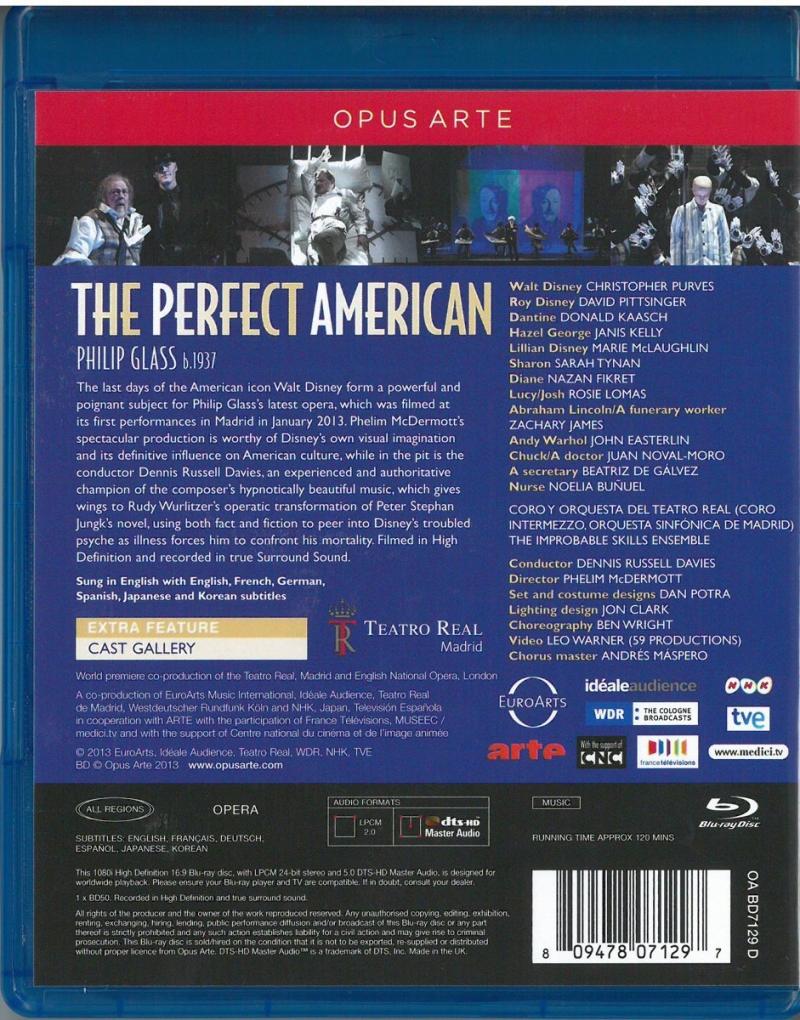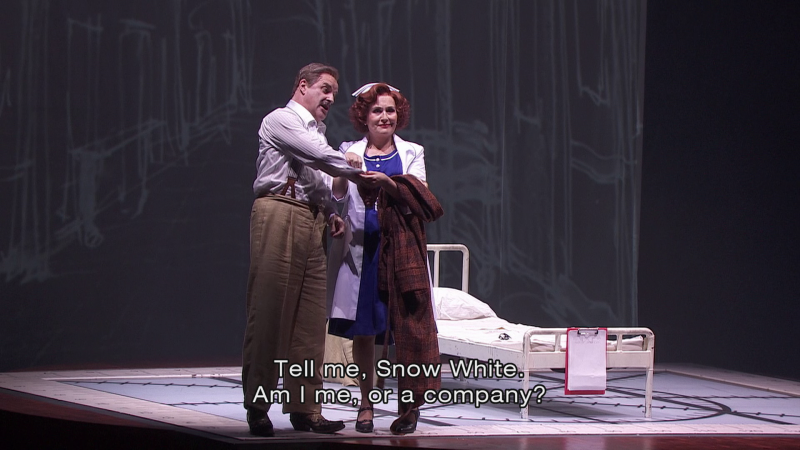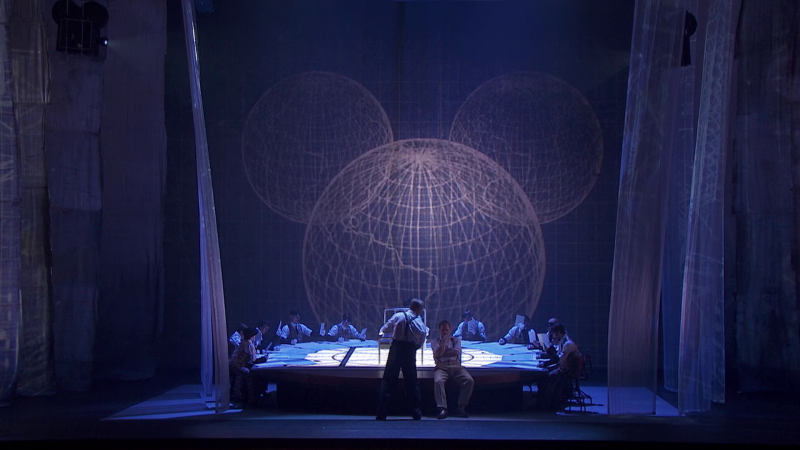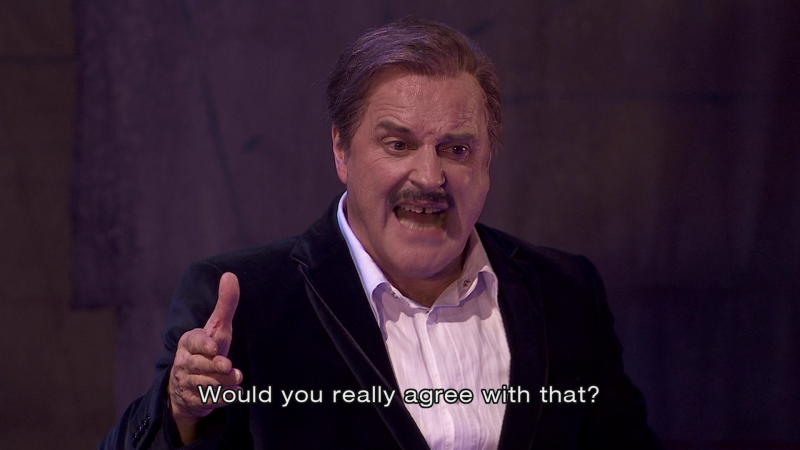

Philip Glass The Perfect American opera to a libretto by Rudy Wurlitzer. World premiere directed January 2013 by Phelim McDermott at Teatro Real in Madrid. Stars Christopher Purves (Walt Disney), David Pittsinger (Roy Disney), Donald Kaasch (Dantine), Janis Kelly (Hazel George), Marie McLaughlin (Lillian Disney), Sarah Tynan (Sharon Disney), Nazan Fikret (Diane Disney), Rosie Lomas (Lucy/Josh), Zachary James (Abraham Lincoln/Funerary Worker), John Easterlin (Andy Warhol), Juan Noval-Moro (Chuck/A Doctor), Beatriz de Gálvez (Secretary), and Noelia Buñuel (Nurse). Dennis Russell Davies conducts the Orquesta y Coro del Teatro Real and The Improbable Skills Ensemble (Chorus Master Andrés Maspero). Sets and costume designs by Dan Potra; lighting design by Jon Clark; choreography by Ben Wright; video projections by Leo Warner (59 Productions). Directed for TV by János Darvas. Sung in English. Released 2013, disc has 5.1 dts-HD Master Audio sound. Grade: B
The world premiere was only 9 months before the release of this disc, so Opus Arte is keeping us avant-garde opera buffs up to date! If you read my review of C(h)œurs, you know how aggressive Teatro Real and its chorus can be. The cover art for this grabbed my attention from the start; I correctly figured out on my own that the perfect American was Walt Disney.
It's hard to get at the truth about Walt Disney! Walt Disney, An American Original, by Bob Thomas, is the only "authorized" biography where the Walt Disney company and the family cooperated. The American Original was published by a Disney affiliate, so you might suspect it's as much a vanity item as a real book. There is one respected unauthorized bio, Walt Disney: Hollywood's Dark Prince, by Marc Eliot. Eliot would seem to be objective, but he had no access to much important information.
Then there is a "fictional biography," Peter Stephan Jungk's 2001 Der König von Amerika (The King of America or The Perfect American.) What the heck is a "fictional" biography? Well, you start with a framework of facts that can be checked, and then you make things up based on what you've heard. The libretto of the opera is based on Jungk's book. So while everything in this opera could possibly be true, there's very little in the opera that you count on as true. Wikipedia has a short article on Walt, but it's very guarded. The truth about Walt may never be known since the family and the company have strong reasons for fighting hard forever to maintain the image of Walt as the patron saint of wholesome family entertainment.
Needless to say, The Perfect American opera is unauthorized. Since the opera is critical, the producers didn't dream of asking for any help or permissions from Disney. Actually this is good for us because we will not be forced to look at any Disney artwork. I've nothing personal against Disney, but I also don't want see Disney cartoon characters. (When I was about 8, I turned away from Disney for good; I was more interested in that poster at the movie theater about The Outlaw with Jane Russell.)
I will now move on to some screenshots and make when I can both authorized and unauthorized comments. The opera opens with Walt on the left (Christopher Purves) and his brother Roy (David Pittsinger) reminiscing about their childhood. These are, of course, sentiments of the patron saint presented in an ironical way. According to unauthorized resources, the Disney boys were mercilessly tyrannized by their abusive father and spend their adult lives trying to create the childhood they never had:
The authorized view is that Walt, the perfect son, husband, and father, was a genius at providing perfect entertainment for American families and therefore deserved at least artistic immortality. The unauthorized view is that Walt, bereft of self-esteem and full of self-loathing, over-compensated in binges of empire-building and delusions of messianic ecstasy:
The authorized view was that Walt was a peerless man without vice. Others say he was a manic-depressive who abused everyone around him, drank too much, hated blacks, Jews, and “queers,” and oscillated between impotency and sexual excess. For sure, he was a life-long chain smoker. When lung cancer promised to cut his life short, he found himself faced with a crisis for which he was not prepared. For a long time there was an urban myth that Walt wanted to be (or was) frozen pending the discovery of the fountain of youth. Per Wikipedia, the family has stated that Walt never contemplated any such bizarre ideas:
Full of anguish, Walt makes everyone swear by the American Flag that they will "never say die." In American English, this just means "don't quit striving." We have no way to know if Walt ever demanded such an oath. But in fact his wish is coming true. The Walt Disney Company has perpetual legal life. And 47 years after Walt's death, the Company is the biggest entertainment company on earth and one of the 30 firms in the Dow Jones Industrial Average, the most popular gauge for measuring the strength of the American stock market:
In the two screenshots above, note the contraption in the fly space that looks like a space station or construction crane. It gyrates about to support the sets by dropping banners and scrims to be used in various ways.
Moving on to the screenshots below, another theme of the opera is a consideration of the work conditions at Disney. The authorized version of the story would make Walt an inspirational business genius. Others claim he was a penny-pinching, unsympathetic, and abusive employer who thought everyone under him deserved the same kind of torment he endured from his father. Here we see Walt and Roy working on business strategy while artists toil on millions of drawings that were needed for an animated film. Note the 3 world figures that make up a mouse-head. This is as close as the our opera producers got to copyrighted Disney designs:
Now we meet Dantine, a disgruntled illustrator who felt he didn't get enough credit. He boldly confronts Walt saying about Dantine's work:
Walt and Roy remind Dantine of the way all employees of high-tech companies sell their souls for bread:
Dantine's retort falls flat. Disney was in fact a fabulously successful executive. He was a pretty good artist (not as good as Dantine) and actor. But Disney's greatest gifts were in the fields of story-telling, marketing, and business entrepreneurship:
Disney created animatronics for his entertainment parks. Here we see an encounter between Walt and Abraham Lincoln in which the robot breaks down and develops a mind of its own. The issue here, of course, is Walt's prejudices. The authorized story is that Walt was "insensitive" about blacks, Jews, homosexuals, and left-wing politics in his youth and early business practices, but that he grew out of this as he and the nation changed. The unauthorized folks say Roy was able to sanitize Walt's image at the same time that Walt informed on Hollywood figures for decades to the FBI! Well, in our first two screenshots, Walt compares himself favorably to Abe:
Abe comes back with a line that had been cut from the script:
Walt then asks Abe if Abe is happy with the way thing have turned out:
Even funnier than Abe's appearance is that of Andy Warhol. You would think that Walt and Andy have nothing in common:
But Andy demonstrates that he and Walt use exactly the same strategies in selling their art. They both (1) represent America, (2) like ordinary things the best, (3) have huge armies of helpers who take orders, (4) portray actors and pop stars as well as themselves, (5) don't criticize America, and (6) don't show ugliness in their work. H'm. The only difference is that Walt would despise Andy whereas Andy loves Walt:
As death approaches, we see Walt in the cancer ward where he befriends a young boy and relates to him with touching kindness. Walt's imaginary animals also visit. As stated already, I don't care much for the saccharine sentimentality of the Disney characters. But the efforts of the designers at the Teatro Real to come up with their own designs points out how hard it is to create attractive cartoon characters. Their most successful design would be the glove-faces:
I think this review gives you good intelligence about the libretto and design of this opera. Just about anyone who knows Philip Glass would instantly recognize the music as his; still, the score was more varied and responsive to the libretto than I expected. The director and designers managed to create a Walt Disney world without using Disney intellectual property—a feat in itself. At first I thought that the issues brought up by the libretto are too shallow to deserve much respect. But on reflection, I realize that the opera did get me to thinking about Walt and Roy. And it led me to discover how little we really know about the Disney brothers and the company they founded. Nobody is going to call this a great opera. But if you think you might like to learn more, I think you should consider this a solid B title.
OR





















